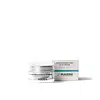What's inside
What's inside
 Key Ingredients
Key Ingredients

 Benefits
Benefits

 Concerns
Concerns

 Ingredients Side-by-side
Ingredients Side-by-side

Water
Skin ConditioningC12-15 Alkyl Benzoate
AntimicrobialCetyl Ricinoleate
EmollientSorbitol
HumectantGlycerin
HumectantC12-20 Acid PEG-8 Ester
EmulsifyingSorbitan Stearate
EmulsifyingGlyceryl Stearate
EmollientPEG-100 Stearate
Carthamus Tinctorius Seed Oil
MaskingSodium Potassium Aluminum Silicate
Glycolic Acid
BufferingMyristoyl Pentapeptide-8
Skin ConditioningMyristoyl Pentapeptide-11
Skin ConditioningSh-Polypeptide-9
Skin ConditioningSh-Polypeptide-22
Skin ConditioningSh-Oligopeptide-4
Skin ConditioningAloe Barbadensis Leaf Juice
Skin ConditioningSodium Hyaluronate
HumectantSaccharomyces Cerevisiae Extract
Skin ConditioningChamomilla Recutita Flower Extract
MaskingAleurites Moluccanus Seed Oil
Skin ConditioningMacadamia Ternifolia Seed Oil
EmollientRosmarinus Officinalis Leaf Extract
AntimicrobialRetinyl Palmitate
Skin ConditioningCamellia Sinensis Leaf Extract
AntimicrobialSaccharum Officinarum Extract
MoisturisingCitrus Medica Limonum Fruit Extract
Skin ConditioningCitrus Aurantium Dulcis Fruit Extract
MaskingPyrus Malus Pulp Extract
Skin ConditioningRetinyl Palmitate/Carrot Polypeptide
Skin ConditioningAscorbyl Palmitate
AntioxidantAscorbic Acid
AntioxidantCitric Acid
BufferingTocopherol
AntioxidantLecithin
EmollientHydrogenated Phosphatidylcholine
EmulsifyingSodium Hydroxide
BufferingPEG-8
HumectantXanthan Gum
EmulsifyingSodium Oleate
CleansingGlycine Soja Oil
EmollientParfum
MaskingLimonene
PerfumingLinalool
PerfumingSilica
AbrasiveDisodium EDTA
Caprylyl Glycol
EmollientEthylhexylglycerin
Skin ConditioningHexylene Glycol
EmulsifyingBenzoic Acid
MaskingPhenoxyethanol
PreservativeCI 40800
Cosmetic ColorantCI 77891
Cosmetic ColorantWater, C12-15 Alkyl Benzoate, Cetyl Ricinoleate, Sorbitol, Glycerin, C12-20 Acid PEG-8 Ester, Sorbitan Stearate, Glyceryl Stearate, PEG-100 Stearate, Carthamus Tinctorius Seed Oil, Sodium Potassium Aluminum Silicate, Glycolic Acid, Myristoyl Pentapeptide-8, Myristoyl Pentapeptide-11, Sh-Polypeptide-9, Sh-Polypeptide-22, Sh-Oligopeptide-4, Aloe Barbadensis Leaf Juice, Sodium Hyaluronate, Saccharomyces Cerevisiae Extract, Chamomilla Recutita Flower Extract, Aleurites Moluccanus Seed Oil, Macadamia Ternifolia Seed Oil, Rosmarinus Officinalis Leaf Extract, Retinyl Palmitate, Camellia Sinensis Leaf Extract, Saccharum Officinarum Extract, Citrus Medica Limonum Fruit Extract, Citrus Aurantium Dulcis Fruit Extract, Pyrus Malus Pulp Extract, Retinyl Palmitate/Carrot Polypeptide, Ascorbyl Palmitate, Ascorbic Acid, Citric Acid, Tocopherol, Lecithin, Hydrogenated Phosphatidylcholine, Sodium Hydroxide, PEG-8, Xanthan Gum, Sodium Oleate, Glycine Soja Oil, Parfum, Limonene, Linalool, Silica, Disodium EDTA, Caprylyl Glycol, Ethylhexylglycerin, Hexylene Glycol, Benzoic Acid, Phenoxyethanol, CI 40800, CI 77891
Water
Skin ConditioningGlycerin
HumectantLactose
HumectantC12-15 Alkyl Benzoate
AntimicrobialCetearyl Ethylhexanoate
EmollientPEG-100 Stearate
Glyceryl Stearate
EmollientPEG-8
HumectantStearyl Alcohol
EmollientTromethamine
BufferingPanthenol
Skin ConditioningCarbomer
Emulsion StabilisingIsopropyl Myristate
EmollientMethylparaben
PreservativeDisodium EDTA
BHT
AntioxidantPropylparaben
PreservativeMagnesium Aspartate
Skin ConditioningZinc Gluconate
Skin ConditioningChlorhexidine Digluconate
AntimicrobialRetinol
Skin ConditioningPolysorbate 20
EmulsifyingCopper Gluconate
Skin ConditioningWater, Glycerin, Lactose, C12-15 Alkyl Benzoate, Cetearyl Ethylhexanoate, PEG-100 Stearate, Glyceryl Stearate, PEG-8, Stearyl Alcohol, Tromethamine, Panthenol, Carbomer, Isopropyl Myristate, Methylparaben, Disodium EDTA, BHT, Propylparaben, Magnesium Aspartate, Zinc Gluconate, Chlorhexidine Digluconate, Retinol, Polysorbate 20, Copper Gluconate
Ingredients Explained
These ingredients are found in both products.
Ingredients higher up in an ingredient list are typically present in a larger amount.
C12-15 Alkyl Benzoate is made up of Benzoic Acid and long chain alcohols. It has a low molecular weight.
C12-15 Alkyl Benzoate is an emollient and texture enhancer. Due to its solubility, it is often used in sunscreens to help evenly distribute active ingredients.
As an emollient, C12-15 Alkyl Benzoate helps soften and hydrate your skin. Emollients create a film on your skin that traps moisture within.
This ingredient has been reported to cause eye irritation.
Learn more about C12-15 Alkyl BenzoateDisodium EDTA plays a role in making products more stable by aiding other preservatives.
It is a chelating agent, meaning it neutralizes metal ions that may be found in a product.
Disodium EDTA is a salt of edetic acid and is found to be safe in cosmetic ingredients.
Learn more about Disodium EDTAGlycerin is already naturally found in your skin. It helps moisturize and protect your skin.
A study from 2016 found glycerin to be more effective as a humectant than AHAs and hyaluronic acid.
As a humectant, it helps the skin stay hydrated by pulling moisture to your skin. The low molecular weight of glycerin allows it to pull moisture into the deeper layers of your skin.
Hydrated skin improves your skin barrier; Your skin barrier helps protect against irritants and bacteria.
Glycerin has also been found to have antimicrobial and antiviral properties. Due to these properties, glycerin is often used in wound and burn treatments.
In cosmetics, glycerin is usually derived from plants such as soybean or palm. However, it can also be sourced from animals, such as tallow or animal fat.
This ingredient is organic, colorless, odorless, and non-toxic.
Glycerin is the name for this ingredient in American English. British English uses Glycerol/Glycerine.
Learn more about GlycerinGlyceryl Stearate is a mix of glycerin and stearic acid.
It is used to stabilize the mixing of water and oil ingredients. By preventing these ingredients from separating, it can help elongate shelf life. It can also help thicken the product's texture.
As an emollient, it helps soften skin and supports barrier-replenishing ingredients.
In cosmetics, Glyceryl Stearate is often made from vegetable oils or synthetically produced.
This ingredient may not be fungal-acne safe
Fun fact: The human body also creates Glyceryl Stearate naturally.
Learn more about Glyceryl StearatePeg-100 Stearate is an emollient and emulsifier. As an emollient, it helps keep skin soft by trapping moisture in. On the other hand, emulsifiers help prevent oil and water from separating in a product.
PEGS are a hydrophilic polyether compound . There are 100 ethylene oxide monomers in Peg-100 Stearate. Peg-100 Stearate is polyethylene glycol ester of stearic acid.
PEG-8 is a synthetic polymer used as a humectant and solvent.
This ingredient is able to help dissolve active ingredients, including water. This gives it humectant properties.
It is soluble in water. The number '8' stands for the molecular weight of the ingredient.
Learn more about PEG-8Water. It's the most common cosmetic ingredient of all. You'll usually see it at the top of ingredient lists, meaning that it makes up the largest part of the product.
So why is it so popular? Water most often acts as a solvent - this means that it helps dissolve other ingredients into the formulation.
You'll also recognize water as that liquid we all need to stay alive. If you see this, drink a glass of water. Stay hydrated!
Learn more about Water